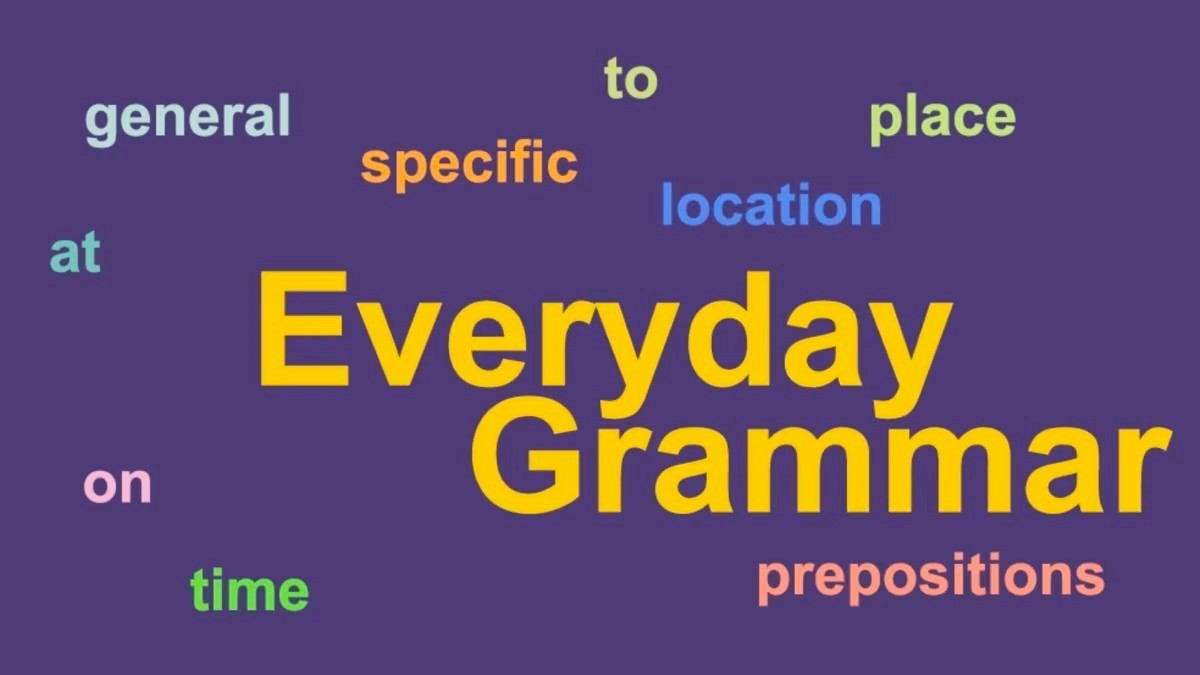Home>Language and Grammar>Quote Unquote: The Ultimate Guide To Using Quotation Marks


Language and Grammar
Quote Unquote: The Ultimate Guide To Using Quotation Marks
Modified: March 3, 2024
Discover the best practices for using quotation marks in language and grammar with our comprehensive guide, Quote Unquote. Master the art of quoting with expert tips and examples.
(Many of the links in this article redirect to a specific reviewed product. Your purchase of these products through affiliate links helps to generate commission for Noodls.com, at no extra cost. Learn more)
Table of Contents
- Introduction
- Understanding Quotation Marks
- Using Quotation Marks in Direct Quotations
- Punctuating with Quotation Marks
- Using Quotation Marks for Titles
- Using Quotation Marks for Emphasis
- Using Quotation Marks for Sarcasm or Irony
- Using Quotation Marks for Definitions or Neologisms
- Using Quotation Marks in Different Languages
- Conclusion
Introduction
Quotation marks, also known as inverted commas, are a fundamental aspect of written language. They play a crucial role in indicating direct speech, denoting titles, highlighting emphasis, and conveying sarcasm or irony. Understanding the nuances of using quotation marks is essential for effective written communication. Whether you're a student, a professional writer, or someone who simply loves language, mastering the art of quotation marks can elevate your writing to a whole new level.
In this comprehensive guide, we will delve into the various facets of quotation marks, exploring their applications in different contexts and languages. From punctuating direct quotations to emphasizing specific words or phrases, quotation marks serve as versatile tools that add depth and clarity to written expression.
Throughout this guide, we will unravel the intricacies of using quotation marks, providing practical examples and insights to enhance your understanding. By the end of this journey, you will have a solid grasp of how to wield quotation marks with finesse, bringing precision and impact to your writing.
So, let's embark on this enlightening exploration of quotation marks, uncovering their multifaceted nature and discovering the art of harnessing their power in the realm of language and communication.
Read more: Top Thinspo Quotes For Ultimate Motivation
Understanding Quotation Marks
Quotation marks, represented by pairs of inverted commas or double quotation marks, serve as essential punctuation in written language. They play a pivotal role in delineating direct speech, indicating titles, emphasizing specific words or phrases, and conveying sarcasm or irony. Understanding the nuances of quotation marks is crucial for effective communication and precision in writing.
Quotation marks are used to enclose direct quotations, signaling the exact words spoken by an individual. When incorporating direct speech into written text, it is customary to encase the spoken words within quotation marks to distinguish them from the surrounding narrative. This practice not only clarifies the source of the quoted material but also enhances the readability and coherence of the written work.
Moreover, quotation marks are employed to denote titles of various works, such as books, articles, poems, songs, and movies. By encapsulating these titles within quotation marks, writers can clearly demarcate them from the rest of the text, ensuring that they stand out and receive the appropriate emphasis.
In addition to these primary functions, quotation marks are utilized to highlight specific words or phrases within a sentence. This usage serves to draw attention to particular terms, indicating their significance or unconventional usage. By employing quotation marks in this manner, writers can effectively convey emphasis and nuance, enriching the overall impact of their writing.
Furthermore, quotation marks are instrumental in conveying sarcasm or irony. When a word or phrase is intended to be interpreted in a non-literal or mocking manner, enclosing it within quotation marks can signal this underlying tone to the reader. This application of quotation marks adds depth and subtlety to written expression, allowing writers to infuse their work with layers of meaning and interpretation.
In essence, understanding quotation marks entails recognizing their diverse roles in written communication. Whether used to punctuate direct speech, denote titles, emphasize specific words, or convey nuanced tones, quotation marks are indispensable tools that enrich the texture and clarity of written language. By mastering the art of utilizing quotation marks, writers can imbue their work with precision, impact, and expressive depth.
This section provides a foundational understanding of the multifaceted nature of quotation marks, setting the stage for a comprehensive exploration of their applications in various contexts and languages.
Using Quotation Marks in Direct Quotations
Quotation marks play a pivotal role in punctuating direct quotations, serving as essential markers that distinguish spoken words from the surrounding narrative. When incorporating direct speech into written text, it is customary to enclose the exact words spoken by an individual within quotation marks. This practice not only attributes the quoted material to its source but also enhances the readability and coherence of the written work.
Consider the following example:
- Without quotation marks: Sarah said that she was "excited about the upcoming event."
- With quotation marks: Sarah said, "I'm excited about the upcoming event."
In the second instance, the use of quotation marks clearly delineates Sarah's precise words, making it evident that the statement is a direct quotation. This distinction is crucial for maintaining clarity and authenticity in written communication.
Moreover, when quoting a dialogue between multiple individuals, each speaker's words are encapsulated within their respective sets of quotation marks. This approach ensures that the exchange of dialogue is presented in a structured and comprehensible manner, enabling readers to discern the distinct voices within the conversation.
Additionally, it is important to punctuate direct quotations accurately. In American English, the closing punctuation mark, such as a comma, period, or question mark, is placed inside the closing quotation mark. For example:
- She exclaimed, "What a delightful surprise!"
- "Have you seen the latest movie?" he asked.
In contrast, in British English, the closing punctuation mark is placed outside the closing quotation mark if it does not form part of the original quotation. For instance:
- She inquired, "Would you like to join us for dinner"?
- "The weather is beautiful today," he remarked.
Understanding the conventions of punctuating direct quotations with quotation marks is essential for maintaining consistency and adhering to linguistic norms. By employing quotation marks effectively in direct quotations, writers can imbue their work with authenticity, clarity, and a compelling sense of dialogue, enriching the narrative and engaging readers in the intricacies of the spoken word.
Punctuating with Quotation Marks
Punctuating direct quotations with quotation marks is a fundamental aspect of written communication, contributing to the clarity, authenticity, and coherence of the quoted material. Proper punctuation not only ensures the accurate representation of spoken words but also enhances the overall readability and impact of the written work.
In American English, the general rule dictates that the closing punctuation mark, such as a comma, period, or question mark, is placed inside the closing quotation mark. This practice aligns with the principle of encapsulating the entirety of the quoted material within the quotation marks, thereby attributing the specific words to their source and maintaining a seamless visual presentation. For example, "She exclaimed, 'What a delightful surprise!'" and "'Have you seen the latest movie?' he asked" adhere to this convention, effectively punctuating the direct quotations in accordance with linguistic norms.
On the other hand, British English follows a distinct punctuation style, where the closing punctuation mark is placed outside the closing quotation mark if it does not form part of the original quotation. This approach reflects a nuanced adherence to the logical flow of the sentence, ensuring that the punctuation mark is positioned in a manner that aligns with the broader grammatical structure. For instance, "She inquired, 'Would you like to join us for dinner'?" and "'The weather is beautiful today,' he remarked" exemplify the application of punctuation marks outside the closing quotation marks in British English.
Understanding and adhering to the appropriate punctuation conventions associated with quotation marks is essential for maintaining consistency and precision in written communication. By punctuating direct quotations in alignment with the established linguistic norms, writers can elevate the authenticity and impact of the quoted material, fostering a compelling and immersive reading experience for their audience.
The nuanced application of punctuation marks within the context of quotation marks underscores the intricate interplay between language, syntax, and visual presentation in written communication. This attention to detail not only enhances the structural integrity of the text but also underscores the writer's commitment to linguistic precision and effective expression.
In essence, the art of punctuating with quotation marks embodies a fusion of grammatical rules, stylistic conventions, and the inherent rhythm of spoken language, culminating in a harmonious and impactful integration of direct quotations within the broader fabric of written expression.
Using Quotation Marks for Titles
Using quotation marks to denote titles of various works, such as books, articles, poems, songs, and movies, is a standard practice in written language. By encapsulating these titles within quotation marks, writers effectively distinguish them from the surrounding text, ensuring that they receive the appropriate emphasis and visibility. This application of quotation marks for titles serves as a fundamental tool for enhancing the organization and clarity of written works across diverse literary and artistic domains.
When referencing the title of a specific literary or artistic work, such as a novel or a painting, it is customary to encase the title within quotation marks. For example, "To Kill a Mockingbird," "The Starry Night," and "The Waste Land" exemplify the utilization of quotation marks to highlight the titles of a novel, a painting, and a poem, respectively. This practice enables readers to readily identify and distinguish the titles from the surrounding narrative or discourse, fostering a seamless and coherent reading experience.
Furthermore, the use of quotation marks for titles extends to various forms of media and creative expressions, including articles, short stories, essays, and individual episodes of television shows or radio programs. For instance, "The New York Times," "The Tell-Tale Heart," "Self-Reliance," and "The One Where They All Turn Thirty" exemplify the diverse range of works that warrant the application of quotation marks to denote their titles. This consistent and standardized approach to punctuating titles with quotation marks contributes to the overall organization and visual clarity of written works, facilitating the effective conveyance of literary and artistic references.
Moreover, the practice of using quotation marks for titles is not confined to traditional printed materials but extends to digital content, online publications, and social media platforms. In an era characterized by the proliferation of digital media and online discourse, the application of quotation marks for titles remains a pertinent and essential aspect of contemporary written communication. Whether referencing an article from an online publication, a blog post, or a digital artwork, the use of quotation marks ensures that titles are appropriately delineated and accorded the necessary prominence within the digital landscape.
In essence, the utilization of quotation marks for titles embodies a universal and enduring practice that transcends literary genres, artistic mediums, and digital platforms. By adhering to the conventions of punctuating titles with quotation marks, writers uphold the integrity and coherence of written works, enabling readers to engage with and appreciate the diverse array of literary, artistic, and digital creations with clarity and precision.
Read more: How To Quote A Song
Using Quotation Marks for Emphasis
The strategic use of quotation marks for emphasis is a powerful tool in the writer's arsenal, allowing for the nuanced highlighting of specific words or phrases within a sentence. By enclosing a word or phrase within quotation marks, writers effectively draw attention to it, signaling its significance or unconventional usage. This application of quotation marks serves to imbue the emphasized elements with heightened visibility and impact, enriching the overall texture and communicative depth of the written work.
When employing quotation marks for emphasis, writers can underscore the importance of a particular term or express a subtle shift in meaning. For example, consider the phrase "The so-called 'experts' failed to anticipate the outcome." In this instance, the use of quotation marks around "experts" serves to convey a sense of skepticism or irony, casting doubt on the expertise of the individuals in question. By employing quotation marks in this manner, writers can infuse their language with layers of interpretation, prompting readers to engage critically with the emphasized term and its underlying connotations.
Furthermore, quotation marks can be utilized to denote non-literal or unconventional usage of a word, signaling a departure from its standard meaning. For instance, in the sentence "Her 'brilliant' idea left much to be desired," the quotation marks around "brilliant" suggest a degree of sarcasm or irony, indicating that the purported brilliance of the idea is being called into question. This subtle use of quotation marks allows writers to convey nuanced shades of meaning, enriching the communicative impact of their language.
Moreover, the application of quotation marks for emphasis extends to the realm of defining or highlighting unfamiliar terms or concepts. When introducing a new or specialized term, writers can encase it within quotation marks to signal its status as a defined term or to draw attention to its specific usage. For example, in the sentence "The 'uncanny valley' effect is a phenomenon in robotics," the quotation marks around "uncanny valley" serve to underscore its status as a defined concept, guiding the reader's attention to its specialized meaning within the context of robotics.
In essence, the judicious use of quotation marks for emphasis empowers writers to imbue their language with subtlety, nuance, and expressive depth. By strategically highlighting specific words or phrases, writers can enrich their writing with layers of meaning, prompting readers to engage critically and interpretatively with the emphasized elements. This practice underscores the dynamic interplay between language, emphasis, and interpretation, elevating the communicative impact and expressive richness of written works.
Using Quotation Marks for Sarcasm or Irony
The application of quotation marks for sarcasm or irony is a nuanced and effective technique in written communication, allowing writers to convey layers of meaning and subtle rhetorical nuances. By enclosing a word or phrase within quotation marks, writers can signal a departure from its literal interpretation, indicating a sense of mockery, skepticism, or incongruity. This deliberate use of quotation marks for sarcasm or irony adds depth and complexity to the written language, inviting readers to engage critically and interpretatively with the underlying tone and intent.
When employing quotation marks to convey sarcasm, writers can subvert the literal meaning of a word or phrase, infusing it with a sense of derision or disbelief. For example, in the sentence "The so-called 'experts' failed to anticipate the outcome," the quotation marks around "experts" serve to cast doubt on the expertise of the individuals in question, subtly implying that their designation as experts is questionable. This application of quotation marks effectively communicates the writer's skepticism or irony, prompting readers to discern the underlying tone and engage with the text at a deeper level.
Similarly, in instances of irony, quotation marks can be used to highlight the incongruity or paradoxical nature of a statement. For example, in the sentence "His 'brilliant' idea left much to be desired," the quotation marks around "brilliant" serve to convey a sense of irony, suggesting that the purported brilliance of the idea is being called into question. This usage of quotation marks underscores the writer's intent to convey a stark contrast between the surface meaning of the word and its actual implications, prompting readers to perceive the underlying irony and interpretative complexity within the text.
Furthermore, the deliberate use of quotation marks for sarcasm or irony allows writers to infuse their language with a discernible tone, fostering a sense of engagement and critical interpretation among readers. This practice underscores the dynamic interplay between language, tone, and rhetorical effect, enriching the expressive depth and communicative impact of written works. By harnessing the power of quotation marks for sarcasm or irony, writers can imbue their language with layers of meaning and interpretative richness, inviting readers to explore the subtleties and complexities of the written word.
In essence, the strategic application of quotation marks for sarcasm or irony underscores the artful manipulation of language, inviting readers to navigate the intricate terrain of rhetorical nuance and interpretative depth within written communication.
Using Quotation Marks for Definitions or Neologisms
The use of quotation marks for definitions or neologisms serves as a valuable tool in written language, allowing writers to introduce, define, or emphasize new or specialized terms within a text. When encountering unfamiliar or coined words, readers rely on contextual cues to discern their meanings and significance. By enclosing such terms within quotation marks, writers provide a visual and contextual signal that guides readers to acknowledge the defined or unconventional nature of these terms.
In the realm of technical, scientific, or specialized writing, the introduction of new concepts or terminologies often necessitates the use of quotation marks to denote their status as defined terms. For instance, in a scholarly article discussing a novel scientific theory, the author may introduce a specialized term such as "quantum entanglement" within quotation marks to explicitly convey its defined nature. This practice not only aids in clarifying the specific usage of the term but also underscores its significance within the context of the discourse.
Moreover, in the context of linguistic evolution and cultural discourse, the emergence of neologisms or coined words requires a deliberate approach to their presentation within written works. By encapsulating newly coined terms within quotation marks, writers acknowledge their unconventional or non-standard status, thereby inviting readers to engage with these terms as novel linguistic constructs. For example, in the exploration of contemporary cultural phenomena, writers may employ quotation marks to introduce and emphasize neologisms such as "technopreneur" or "infodemic," signaling their status as recently coined terms that warrant attention and interpretation.
Furthermore, the use of quotation marks for definitions or neologisms extends to the realm of creative writing, where authors may introduce invented words or fantastical concepts within their narratives. By enclosing these imaginative constructs within quotation marks, writers establish a distinct visual and contextual framework that guides readers to perceive these terms as unique and defined within the fictional universe. This practice not only enriches the imaginative depth of the narrative but also fosters a sense of immersion and interpretative engagement among readers.
In essence, the deliberate use of quotation marks for definitions or neologisms underscores the dynamic interplay between language, innovation, and reader engagement within written communication. By employing quotation marks to introduce and define new or specialized terms, writers navigate the evolving landscape of language, fostering clarity, precision, and interpretative richness within their works.
Using Quotation Marks in Different Languages
The utilization of quotation marks varies across different languages, reflecting the diverse linguistic conventions and typographical practices that characterize written communication worldwide. While the fundamental purpose of quotation marks remains consistent – to delineate direct speech, denote titles, emphasize specific words, and convey sarcasm or irony – the specific typographic forms and usage conventions of quotation marks exhibit notable variations across languages.
In English, the standard practice involves the use of double quotation marks (“ ”) to encapsulate direct speech, titles of works, and emphasized words or phrases. However, in languages such as French and Spanish, typographical conventions dictate the use of angled quotation marks (« » or ‹ ›) to enclose direct speech and quotations. This distinctive typographic feature reflects the specific stylistic and typographical traditions inherent to these languages, contributing to the visual and aesthetic diversity of written texts.
Moreover, the placement of punctuation marks in relation to quotation marks varies across languages, further underscoring the nuanced typographic differences. For instance, in American English, the closing punctuation mark is positioned inside the closing quotation mark, while in British English, it may appear outside the closing quotation mark in certain contexts. Similarly, the punctuation conventions in languages such as German and Italian adhere to distinct typographic rules, reflecting the intricate interplay between language, syntax, and visual presentation.
In addition to typographical variations, the cultural and linguistic nuances associated with quotation marks in different languages contribute to the rich tapestry of written expression. The subtle nuances of conveying sarcasm, irony, or emphasis through quotation marks are intricately intertwined with the linguistic and cultural ethos of each language, shaping the interpretative dynamics of written communication.
Furthermore, the application of quotation marks in multilingual or translational contexts necessitates a nuanced understanding of typographical and linguistic conventions. Translators and writers navigating diverse linguistic landscapes must adeptly navigate the distinctive typographic forms and usage norms of quotation marks in each language, ensuring the faithful and culturally resonant representation of written texts across linguistic boundaries.
In essence, the diverse typographic forms and usage conventions of quotation marks in different languages reflect the intricate interplay between language, culture, and visual representation. By embracing the varied typographic traditions and linguistic nuances associated with quotation marks, writers and translators enrich the global tapestry of written communication, fostering a harmonious convergence of diverse linguistic and typographical expressions.
Conclusion
In conclusion, the nuanced and versatile nature of quotation marks transcends mere punctuation, embodying a rich tapestry of linguistic expression and communicative depth. From punctuating direct quotations to denoting titles, emphasizing specific words or phrases, and conveying sarcasm or irony, quotation marks serve as indispensable tools that enrich the texture and clarity of written language.
The art of wielding quotation marks with finesse lies in understanding their multifaceted applications and embracing the diverse typographic and usage conventions across different languages. Whether navigating the distinct punctuation styles of American and British English or embracing the angled quotation marks of French and Spanish, writers and translators must adeptly navigate the intricate typographic forms and cultural nuances associated with quotation marks.
Moreover, the strategic use of quotation marks for emphasis, sarcasm, or defining neologisms empowers writers to imbue their language with layers of meaning, prompting readers to engage critically and interpretatively with the written word. This deliberate application of quotation marks underscores the dynamic interplay between language, tone, and rhetorical effect, fostering a sense of immersion and interpretative engagement among readers.
As writers embark on the enlightening journey of quotation marks, they are invited to explore the subtle nuances of language, the expressive richness of written communication, and the diverse typographic traditions that shape the visual landscape of texts. By mastering the art of utilizing quotation marks, writers can infuse their work with precision, impact, and expressive depth, fostering a harmonious convergence of diverse linguistic and typographical expressions.
In essence, the comprehensive guide to using quotation marks unravels the intricate art of punctuation, inviting writers to harness the power of quotation marks to elevate their writing to a whole new level. Through a nuanced understanding of their applications in various contexts and languages, writers can navigate the evolving landscape of language, fostering clarity, precision, and interpretative richness within their works.













